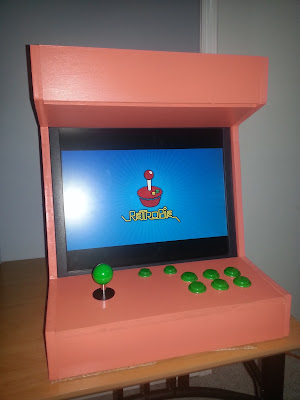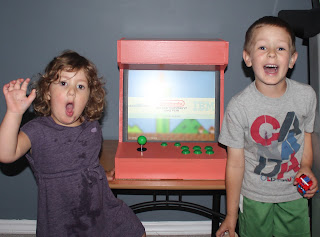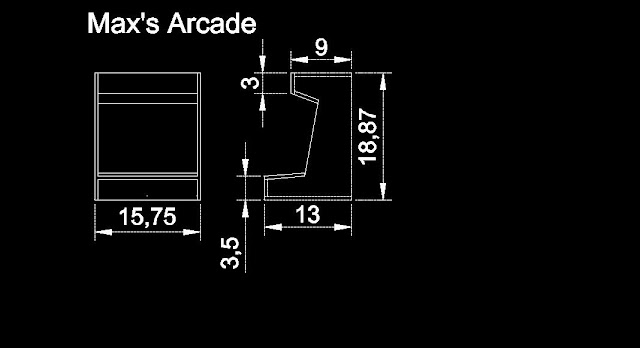*The information found in my blogs is provided for free; I
do want people to use the information and reproduce or expand on my
projects. If you produce a blog or publish work using the information
found here and are using elements that are unique to my designs, I
simply ask that you link back to my blogs and videos and credit the
resource as a courtesy to myself and others who take the time to add to
the online electronics hobby community.
Moving along... I decided that I still wanted a machine anyway, so it might not be as polished as it
would have been if I made it as a capstone project, but it definitely has all the components needed for a good time! My only partner for this home project was my son Max.
The system is based around the popular Raspberry Pi model B computer (Check the link if you don't know about this computer), running the RetroPie software, which is available free (or donation) which boots your machine directly into a menu which allows you to select your emulator.
The next component to worry about was the joystick and buttons. I dug around on eBay, and it looked like my best bet was to buy a kit. It's hard to link to auctions that end, but here's a try: joystick I bought
This is a picture of the kit if you wish to find the auction or buy one similar. The seller was fair, and I did receive it in a timely manner. I was however unimpressed with the buttons. The final arcade machine has the board with the controls screwed in, so I can remove it later, as I may yet swap them out. They do seem to do the trick and haven't given me much trouble, but they are a non-standard size; I didn't have a hole-saw the proper size, so the fit wasn't great. I did do an unboxing video for this set on YouTube. I was pretty upset in the video, but it worked out, the seller was fine, and the USB joystick adapter board did work fine with Mame/RaspberryPi, so if you're on a budget, you may still consider this set as an option.
The next step in the project wasn't mandatory, but it did simplify the project. I took the monitor apart so that I could remove it from the stand and enclosure, and also so I could try to steal power for the Raspberry Pi from it. I made the assumption that the circuitry and buttons on the monitor were being powered by a 5V supply line, and I was curious to see if I could tap into that.
I had to decide on dimensions for the cabinet now, and the only thing I really knew for sure was the size of the monitor. I went into draftSight and started drawing out what I thought would work well, and I came up with this:
DWG File
To build the cabinet, I decided on a 4'x4' sheet of 1/2" MDF, as it was only $20 at Home Depot and the texture is preferable to plywood. Cutting and painting was the most time-consuming aspect of the project. Here is the video we made of us cutting out the parts using a table-saw and a jig-saw.
The panels were assembled by pre-drilling holes then putting nails in. A better method would be to use a router and cut grooves in, but I made due with what I had, and it worked out just fine. If you don't drill first, you will most certainly split the wood! I also cut the bottom part of plastic off the monitor which originally held the user buttons (I simply used a back-saw).
To add sound to the project, I decided to use LM386 amplifiers attached to speakers I picked up from the surplus store. I had all the electronics parts I needed on hand, so it worked out well. You may consider using computer speakers instead, but I feel my approach made the project a little more personal.
Link to Stereo LM386 Amplifier project
(It is complex enough that I don't want to get into too much detail here). This is a video demonstration of the LM386's in a stereo configuration, mechanically joined by two logarithmic potentiometers, and being powered off of a 5V pin from the Raspberry Pi:
Here we have the unveiling of the arcade cabinet:
This is pretty much how it will stay until I get the new Raspberry Pi. The project was fun, and I think I enjoyed building it more than I like playing on it! You may find you need to go into the RaspPi config and overclock it to 900MHz (if you're using an original Pi, not the Pi 2), as I was having some stutters in some games, but at 900 MHz, most of the stuff I was doing ran just fine.
There you have it, the Pi Arcade Machine. I know this project has been beat to death, and loads of
information has been done, but hopefully this info still encourages or helps someone out. This has also been one of my more popular projects (as far as social media goes), and I'm happy to add more Raspberry Pi projects to the internet! Thanks for checking this out, and I'll leave you with one last thing, my blooper reel from building the cabinet.



